The Kentucky Transportation Cabinet recently issued a new version of its “Complete Streets” roads and highways manual; a revision that represents the first update in more than 20 years to Kentucky’s pedestrian and bicycle travel policy.
[Above image via the KYTC]
“Highway safety has been one of my top priorities,” noted Governor Andy Beshear (D) in a statement.

“And that means safety for everyone who uses our transportation system – motorists, motorcyclists, transit riders, bicyclists and pedestrians,” he added. “This provides valuable guidance to equip transportation industry partners across all levels to consider multi-modal systems when planning to support equity and accessibility in communities.”
KYTC pointed out that a “complete street” is one “safe and accommodating” for all users – be they motorists, bicyclists, or pedestrians. Its design can vary according to land use, corridor characteristics and types of travelers using it. As a concept, “complete streets” can also can be adapted for all types of communities – urban, suburban, small town, and rural areas.
Implementation may include a dedicated space for pedestrians and cyclists, such as bike lanes, wide paved shoulders, sidewalks, crosswalks, median islands, accessible pedestrian signals, roadway reconfigurations and roundabouts, the agency noted.

“Historically, streets, roads and highways were designed around cars and trucks,” explained KYTC Secretary Jim Gray.
“Today, our transportation planners and designers approach their tasks holistically, taking the needs of all users into account and building accordingly,” he added. “There’s no one-size fits all recommendation as roadway features must be tailored to fit the community context.”
To elevate the state’s safety and equity priority, Gray also signed an official order outlining KYTC’s policy to meet needs of all users and requirements of the Americans with Disabilities Act when planning, building, rehabilitating and maintaining all state-maintained streets and roads.
Those users include motorists, cyclists, pedestrians, transit and freight, benefitting people of all ages and abilities, the agency said.
 States
States
Georgia DOT Foreman Receives Two Heroism Awards
January 2, 2026 States
States

